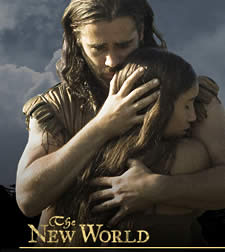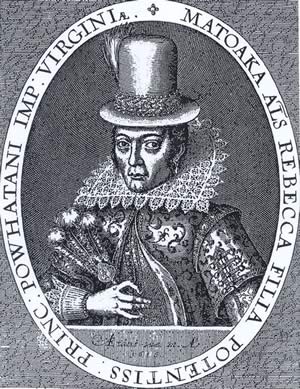Historic Distortions

I recently watched The New World (2005), yet another rendering of the historic account of Pocahontas and John Smith. Though recorded history of the detailed interaction between these two characters is limited, enough is known to confirm that this new movie is yet another Hollywood distortion of truth for the sake of marketable cinema. Supposedly more pains were taken to produce a higher level of historical accuracy than Disney's animated Pocohontas (1995), but both stories contain myth and are factually inaccurate.
From a cinematic perspective, The New World was endearing. Though there is no historical evidence of any romance, I enjoyed this film's depiction of internal conflict. John Smith's love for Pocahontas led him to struggle with his desire to leave all things England and join his muse in a wild, dreamy life of love. His experience with the native culture led him to believe that their way of living was more real and less polluted with passion, greed and strife. When he returned to the English fort after his "capture" he found nothing but disease, death and despair. The few who survived bickered and argued over meaningless things, and those with pride fought for a controlling position. These dreary, muddy images were quite effectual. I was thinking, "Ew, Smith. Just go back. Go back to your rich newfound love. Live with the natives and enjoy their apparently more basic existence." Such is Smith's debate. In the end, he chooses duty and perhaps the promise of restoration and importance.
The film's power is in its imagery. The dialog is very limited, the story told through a series of emotive images and interactions. As I was reading what some others have written about the movie, I noticed two opposing reactions. Many praise the movie for its beautiful imagery, religious implications and flim presence. Others write it off and nearly walking out of the theater, bored out of their minds. I can appreciate both reactions, but I tend more towards appreciation. The plot was a little incomplete and broken in places, and there were many periods of almost emptiness, silence and peace. Though there were a couple dead moments my attention was not lost, and I wanted to see the story completed.
In the end, I was a little lost in the relationships, and perhaps my hopes for resolution were disappointed. The end is somewhat odd when the perspective of the film moves to Pocahontas' life after John Smith leaves for England. She is in deep sorrow, convinced that her invaluable love is lost forever. But then she moves on, and there is a strangely depicted love triangle in the end. Too comlicated, I think.
If the director would have looked more into the historical account of Pocahontas (Matoaka), he could have avoided some of the strange unresolved relational situations. History gives us absolutely no indication of a romance between John Smith and Pocahontas. Pocahontas was a mere 10 years old when John Smith arrived, and Smith simply related to her with fondness and friendship. It's interesting to me that the movie never refers to Pocahontas with any name except "Rachel", her Christian name given her when she is accepted into English society. "Pocahontas" was a name the colonists gave her because of her playful nature. Her real names were Matoaka and Amonute.
 This is the only portrait of Pocahontas made during her lifetime. All others are even more europeanized, so there is no way to tell what she actually looked like. I can see Hollywood straying from this likeness though - this simply wouldn't sell! I think it's probably a bad likeness anyway - looks more like an 80 year old man than a vital 21 year old.
This is the only portrait of Pocahontas made during her lifetime. All others are even more europeanized, so there is no way to tell what she actually looked like. I can see Hollywood straying from this likeness though - this simply wouldn't sell! I think it's probably a bad likeness anyway - looks more like an 80 year old man than a vital 21 year old.
The movie made it seem as though John Smith left for England due to his battle of conscience, not able to commit to his passion for the girl. In reality he went to England due to an injury, and Pocahontas was later told of his "death". John most likely didn't intentionally mislead her in order to detach himself for his conscience' sake, as the movie suggests. A few years later, she married John Rolfe. Interestingly enough we have Rolfe, a deeply pious man, to thank for being the first to commercially cultivate tobacco in the New World! The emotional conflict in the movie would have been better attributed to Rolfe, for history records his deep love for Pocahontas, his conscience battle, and his letter to the governor explaining his desire to marry a "heathen". Some years after their marriage, Rolfe and Pocahontas traveled to London, primarily for the purpose of gaining more support for the Virginia colony by way of impressing royalty with a "tamed" native. While in London, Pocahontas met John Smith, having heard of his being alive before she left Virginia. After a period of emotional awkwardness, she refers to him as "father" and ensures a restored friendship. When she, Rolfe and their son Thomas were to return to the colony Pocahontas became very ill and died. She was only 22. Perhaps the movie's most accurate piece was her final words, "All must die. 'Tis enough that the child liveth.".
I'm glad I took the time to look up this information on Pocahontas. It would have been easy to accept Hollywood's version as fact and enter into conversation and thought patterns based on such historical inaccuracy. It's somewhat unfortunate, furthermore, and I think many Americans are mostly blind to cultural and historical truth, partially due to this sort of misinformation. Oh well, it's all fictional and for entertainment, and no one is obligated to tell the truth on film, I guess.